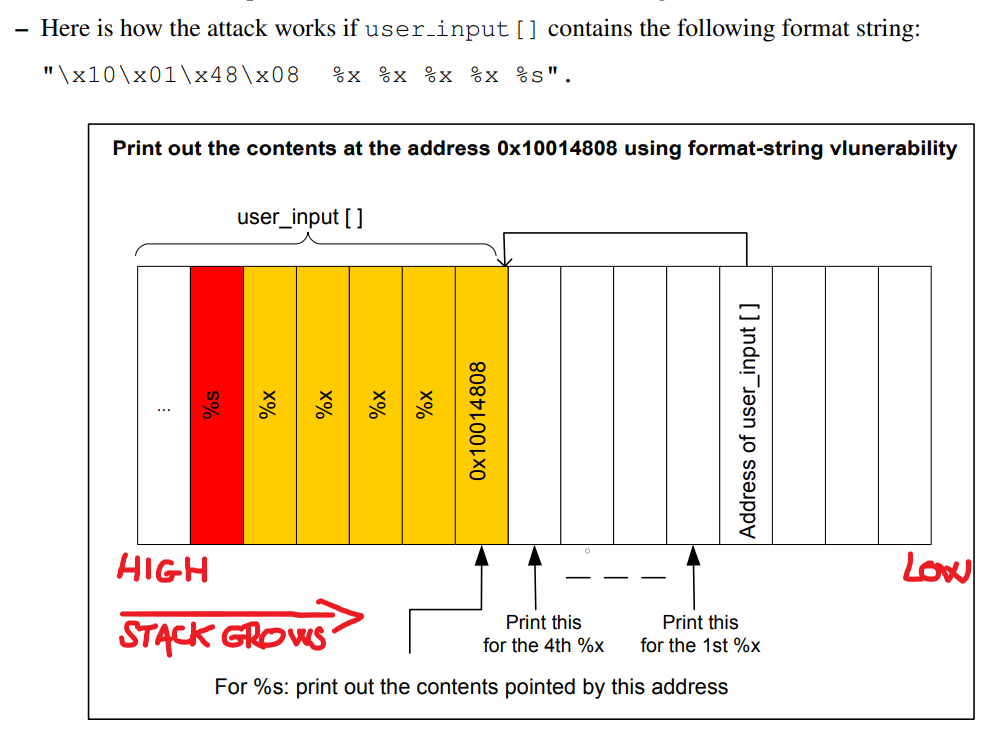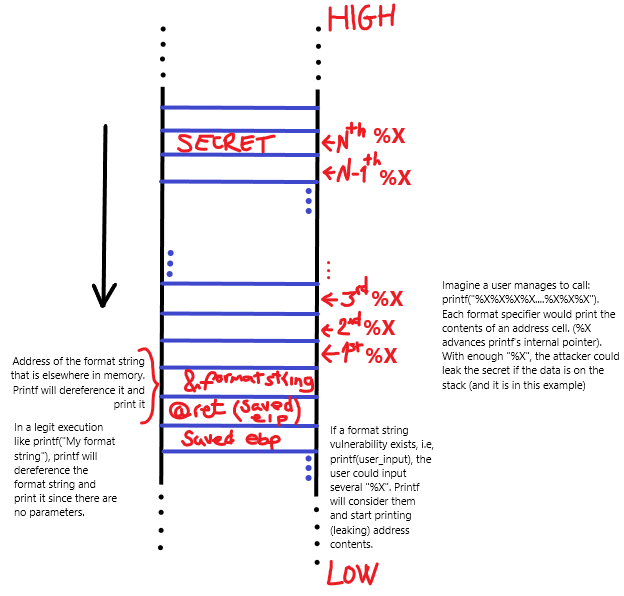
This binary exploitation challenge is, at the moment of writing this walkthrough, rated as EASY with a difficulty score of 2.22 out of 5.0. Its description states the following:
Can you abuse our confused environment service to read flag data hidden in an environment variable?
There is no binary to download and reverse this time. Instead, we are given a URL and a port to connect to. In order to connect, I’ll be using netcat along with rlwrap. In case you are wondering what rlwrap does, it basically wraps the readline commands and allows a user to use arrow keys with commands line netcat, avoiding the annoying and infamous ^[[D^[[A and such.
Connecting to the challenge is as easy as rlwrap nc URL PORT

Given that we can only interact with the execution of the binary and we have no idea what the source code is, the natural step to follow is to try several inputs and see if it breaks, looking for possible vulnerabilities. As shown in the image above, the binary is vulnerable to FORMAT STRING. There are several
- Format string vulns in gory detail, by Ron Bowes. Link
- Exploiting Format String vulnerabilities, by scut from Team Teso. Link
- Format string exploitation tutorial, by Saif El-Sherei. Link
- Exploit 101 - Format Strings, by Alexandre Cheron. Link
- Format string attack, by OWASP. Link
- Format string exploitation, by Fuzzysecurity. Link
- Format string vulnerability, by Syracuse University. Link
- This one is also very good, but in Spanish. Link
You can also learn about format string in video format, LiveOverflow’s videos on the topic are very recommended.
I will briefly introduce the format string vulnerability so everyone reading this can understand what is actually happening. If you want to go deeper into the topic, please read the articles linked above.
A format string vulnerability happens when a printing function, like printf, that works with format specifiers, like %d, is misused. That is, the parameters passed to the function do not follow its intended behavior.
For example, a correct use of the printf function is: printf("Your name is %s", name);, while the following example is vulnerable to format string: printf(name);. Imagine if the variable name is controlled by the user. A given user could input things like %s or %x (or any valid format specifier). The result would be memory leaking, abusing the format string vulnerability.
Basically, the vulnerability happens because printf (and all of the functions within the family) have a variable number of arguments. The number of arguments is defined by the number of format specifiers (characters starting with %) within the format string itself. That is, a format string like printf("Exploit %s, not %s.", "code", "people"); will expect two arguments and the function will retrieve them from the stack regardless the correctness of its invocation. In other words, the statement printf("%x%x%x%x"); will print 4 arguments from the stack as hexadecimal, even though they were not specified when calling the function.
There are several format specifiers we can use to leak information from the stack. In fact, printf family functions work with format specifiers, and several sub-specifiers like flags, width, precision or length following the %[flags][width][.precision][length]specifier pattern. I recommend you to read this documentation to find out all the valid specifiers. The next image shows the most common format specifiers when exploiting a format string vulnerability (Source).

Please note that some specifiers work with pointers. That is, they expect a pointer and, as such, they will dereference (or try to) the address they point to.
Leveraging a format string vulnerability to leak memory data is possible because functions assume the stack is configured according to the number of format specifiers they will read from the stack.
Specifically, stack’s behavior when exploiting the vulnerability is shown in the image below. (Source)

In order to depict the behavior of the stack and the internal printf’s pointer, I drawn the next figure. Please bear in mind that the behavior of the function is the same, regardless of the vulnerability. What differs is the intended data being printed or the actual leaking of information.

Another important thing to note is that printf functions allow the use of positional parameters.
Now, sticking to our challenge, in order to abuse the vulnerability and leak memory contents, we can make use of the positional specifier and the string format specifier. As it was aforementioned, the %s format specifier expects a pointer to a string. That is, the address will be dereferenced and if it is invalid, the program will crash (netcat connection will close).
Since we don’t control what addresses are placed on the stack and neither can we debug it, my approach was to simply leak each and every address from the stack. That is, iterate and step through every position following the next pattern: %{index}$s where index starts at 1. In the next execution, index = index + 1 and so forth. This pattern translated to a format specifier with the corresponding positional argument is as simple as $1$x.
# RazviOverflow
# Python3
from pwn import *
# Iterate through positions 1 to 199
for index in range(1,200):
payload = "%{}$s".format(index)
# Establish connection
binary = remote("XXX.247ctf.com", 00000)
binary.recv()
binary.sendline(payload)
response = binary.recv()
# In case there is en error or EOF is received,
# we close connection and continue leaking next position
try:
if b"247CTF" in response:
print("[+] Found flag at position {}.".format(index))
print(response)
break
except Exception as ex:
binary.close()
Executing the exploit that abuses the vulnerability and leaks the memory, we will eventually leak the corresponding environment variable.

I hope you enjoyed my write-up. I’d be delighted to know whether it helped you progress and learn new things. Do not hesitate to reach me out via Twitter. I’m always eager to learn new things and help others out :)
More challenges
- Click here to see 247CTF index.